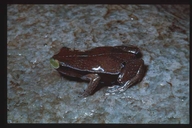|
Description
A large species of Paratelmatobius (SVL 19.2-23.3 mm). First described by Lutz and Carvalho (1958) . Color in life from Pombal Jr. and Haddad (1999) based from the original color plate and slides follows:"Dorsum dark brown; in some specimens canthus rostralis, loreal region, and snout are pale green instead of dark brown; throat brown; ventral surface of thigh gray with white blotches; ventral surfaces of tibia, arm, and forearm red; inner carpal surfaces with a gray blotch on a dark brown background; ventral surfaces black with whtie and red blotches." P. lutzii has a flat snout, indistinct tympanum, males lack vocal slits, well developed dorsolateral stripes and lacks a tubercle on the edge of the upper eyelid and base of mandible. Nuptial pad does not have spicules, first finger is shorter than second, and tip of the third finger is rounded. Foot webbed. Tips of toes not dilated. Ventral and dorsal surfaces are smooth, with ventral surfaces black with white and red stains. Distribution and Habitat
Country distribution from AmphibiaWeb's database: Brazil
Only known from the type locality at Alto do Itatiaia inthe Serra da Mantiqueira, State of Minas Gerais, Atlantic Forest, souteastern Brazil. Since its original description, the locality has been visited seven times and no specimens have ever been found.Life History, Abundance, Activity, and Special Behaviors
One female was found to have 23 ovules with an average diameter of 1.9 mm and another with 31 ovules with an average diameter of 2.2 mm.
References
Lutz, B., and A. L. Carvalho (1958). ''Novos anfibios anuros das serras costeiras do brasil.'' Mem. Inst. Oswaldo Cruz, 56, 239-249.
Pombal Jr., J. P. and Haddad, C. F. B. (1999). ''Frogs of the genus Paratelmatobius (Anura: Leptodactylidae) with descriptions of two new species.'' Copeia, 1999(4), 1014-1026.
Originally submitted by: Raul E. Diaz (first posted 2004-06-04)
Edited by: Tate Tunstall (2004-08-19)Species Account Citation: AmphibiaWeb 2004 Paratelmatobius lutzii <https://amphibiaweb.org/species/3379> University of California, Berkeley, CA, USA. Accessed May 29, 2025.
Feedback or comments about this page.
Citation: AmphibiaWeb. 2025. <https://amphibiaweb.org> University of California, Berkeley, CA, USA. Accessed 29 May 2025.
AmphibiaWeb's policy on data use.
|





 Map of Life
Map of Life